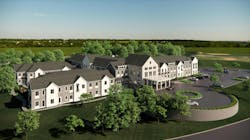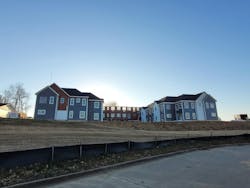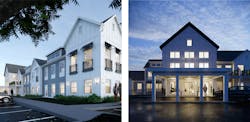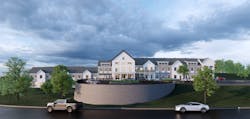Navigating architectural challenges—from 'unbuildable' to unbelievable
The architectural domain constantly offers challenges. Tackling them with innovation and expertise is the very essence of an architect's job. We often find opportunities buried within the greatest challenges of a project when we stop to look.
We took on an exceptional project for a mother-daughter duo with vast experience in the senior living domain, helping them on their maiden voyage into creating a facility on their own. After they secured the land, we launched the project together into the coming storm of the Covid-19 pandemic. The property had some admirable qualities in terms of accessibility and proximity to healthcare services but came with a significant challenge.
The Hill
The selected site, located on the south side of Cape Girardeau, Missouri, was anything but typical. Its unique position—a conspicuous hill slightly outside the denser parts of town—became both a significant challenge and a fantastic opportunity. An initial observation from a contractor even deemed it 'unbuildable,' but we believe in facing challenges head-on and have been taught to turn liabilities into opportunities.
Several approaches were explored to address the grade while maintaining efficient operation. These included tracking the grade with the building, maintaining a compact footprint, and stepping down the hill. While all of these were employed, stepping down the hill was the most noteworthy.
Overcoming Design Challenges
While geotechnical exploration was done to check for likely obstacles, the potential for high bedrock meant keeping the floor level high in areas would minimize the risk of encountering a surprise. The stepped approach allowed us to avoid those potential hurdles while making use of the lower portion of the site. While this approach provided a solution to the main problem, it wasn’t devoid of challenges. Ensuring services to the lower level—especially food service—was critical.
The central kitchen was placed on the main level, the Assisted Living area, with a robust prep space on the lower level fed by a dumbwaiter to serve Memory Care. Stepping down the hill also meant the lower level would have a long retaining wall on at least one side, cutting off natural light. To address this, service areas were moved to the back, the ceiling was held high, and glass was maximized at the exterior to keep the space bright and welcoming.
The overall approach to the design process was traditional but with a couple of twists. First, specific strategies were employed to reduce earthwork. Second, we utilized a home-grown library of computer modeling tools that allowed us to quickly and accurately iterate blocking and stacking options, including floor plans and 3D Views imposed on the existing site.
The design, while challenging, brought forth several advantages:
- Drastically reduced earthwork, leading to considerable cost savings.
- A natural distinction between the assisted living and memory care spaces.
- Distributed parking solutions.
- The opportunity to take advantage of the hill, accentuating the entrance with a sense of grandeur.
- An approachable scale was maintained by distributing wings across a compact footprint so the whole building could not be seen from any vantage point on the ground. This also had the effect of making key amenities accessible from the remotest areas.
Working With A Unique Client Profile
A unique facet of this project was the client profile. Working with clients who lacked prior construction experience had its own set of challenges and advantages. Guiding them through the architectural process, understanding their preferences, and ensuring their vision was met, required care and planning. This was significantly compounded by the challenges and uncertainties introduced by the pandemic, but it also contributed to an openness to exploration, resulting in a beautiful product.
Facing Pandemic-Induced Challenges
The pandemic brought about challenges no one had ever faced; shifting from traditional office-based design to a remote setup created a unique working dynamic. Balancing this new work setup with clients inexperienced in construction, and strict budget expectations was quite a journey.
Along with the challenge of learning a new way to work, we found a new opportunity. Working in an office generally requires specific, intentional, and committed collaborative work sessions, and it’s generally not possible to participate in them while working on other aspects of the project. This results in ideas not being tested immediately, and stopping other work while they are reviewed.
Maintaining open collaborative sessions between team members allowed us to be “online” with each other on an ongoing basis, where quick and immediate pauses could be made for collaboration. This approach is neither necessary nor helpful in all phases of a project, but in early design, it can improve upon traditional in-office work.
Turning Challenges Into Opportunities
This project was a testament to the belief that challenges can be transformed into opportunities. Whether it was the daunting hill or designing during the pandemic, each obstacle was met with innovation and determination. The result is a state-of-the-art senior living facility that stands tall, literally and metaphorically, representing an incredible mother-daughter team's combined dreams and aspirations. In facing and overcoming the challenges of the hill, the design team not only crafted a safe, modern home for seniors but also set a benchmark for future hillside projects.
On the Building Team:
Developer: Newbridge Retirement Community
Architect: Vessel Architecture & Design
Structural Engineer: SSC Engineering
Civil Engineer: Bowen Engineering & Surveying
MEP: SSC Engineering
Interior Design: Rust & Martin
GC: IMPACT Strategies




